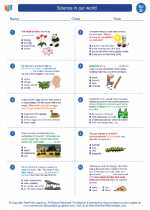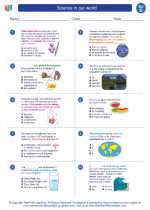Science in our world -> weather patterns
Weather Patterns
Weather patterns refer to the recurring atmospheric conditions in a specific area over a period of time. These patterns are influenced by various factors such as temperature, air pressure, humidity, and wind direction.
Factors Influencing Weather Patterns
- Temperature: The amount of heat in the atmosphere affects the types of weather patterns that occur.
- Air Pressure: Variations in air pressure can lead to the formation of high or low-pressure systems, which in turn influence weather patterns.
- Humidity: The amount of moisture in the air plays a significant role in the formation of precipitation and cloud cover.
- Wind Direction: Wind patterns can bring in air masses from different regions, impacting the weather in a particular area.
Types of Weather Patterns
Weather patterns can vary widely, but some common types include:
- High Pressure Systems: These systems typically bring clear skies and calm weather.
- Low Pressure Systems: Low pressure often leads to cloudy, stormy conditions with the potential for precipitation.
- Fronts: Frontal boundaries where different air masses meet can result in changes in weather patterns, such as the development of rain or thunderstorms.
- Seasonal Patterns: Weather patterns can also be influenced by the changing seasons, leading to predictable shifts in temperature, precipitation, and wind patterns.
Studying Weather Patterns
To understand and study weather patterns, scientists use a variety of tools and methods, including:
- Meteorological Instruments: Devices such as thermometers, barometers, anemometers, and rain gauges help measure and monitor weather conditions.
- Satellite and Radar Technology: Advanced technology allows scientists to track and analyze weather patterns from space and detect approaching storms.
- Computer Models: Meteorologists use computer simulations to predict future weather patterns based on current data and historical trends.
- Observation and Data Analysis: Weather stations and observatories collect data on temperature, humidity, air pressure, and wind speed to identify and interpret weather patterns.
Conclusion
Weather patterns are complex and dynamic, shaped by a combination of natural factors and human activities. By studying and understanding these patterns, scientists and meteorologists can provide valuable forecasts and warnings to help people prepare for and adapt to changing weather conditions.
[Weather Patterns] Related Worksheets and Study Guides:
.◂Science Worksheets and Study Guides Fourth Grade. Science in our world
Study Guide Science in our world - 4th gr.
Science in our world - 4th gr.  Worksheet/Answer key
Worksheet/Answer key Science in our world - 4th gr.
Science in our world - 4th gr.  Worksheet/Answer key
Worksheet/Answer key Science in our world - 4th gr.
Science in our world - 4th gr.  Worksheet/Answer key
Worksheet/Answer key Science in our world - 4th gr.
Science in our world - 4th gr.  Vocabulary/Answer key
Vocabulary/Answer key Science in our world - 4th gr.
Science in our world - 4th gr. 

 Worksheet/Answer key
Worksheet/Answer key
 Worksheet/Answer key
Worksheet/Answer key
 Worksheet/Answer key
Worksheet/Answer key
 Vocabulary/Answer key
Vocabulary/Answer key

The resources above cover the following skills:
History and Nature of Science: A student should understand the history and nature of science. A student who meets the content standard should:
Develop an understanding that historical perspectives of scientific explanations demonstrate that scientific knowledge changes over time, building on prior knowledge.
Develop an understanding that scientific knowledge is ongoing and subject to change as new evidence becomes available through experimental and/or observational confirmation(s).